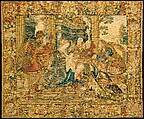Adoration of the Kings
Design attributed to Bernard van Orley Netherlandish
Elements of the central group are derived from Tommaso Vincidor (Tommaso di Andrea) Italian
Possibly woven in the workshop directed by Pieter van Aelst the Younger Flemish
Not on view
Though small in size, this rich devotional tapestry, woven with virtuoso technique in the priciest of raw materials, embodies the highest end production associated with early sixteenth-century Brussels. Complementing its physical appeal was the caliber of its designer, Bernard van Orley, wo was admired official court painter to both Margaret of Austria and, subsequently, Mary of Hungary. With fleeting movement, gorgeously observed draperies billowing, the three kings launch themselves into this scene, as if having just strode into the tapestry from behind its left and right borders.
This is a more dynamic version of a design van Orley also executed in oil on panel in a painting now in the collection of the Philadelphia Museum of Art. Van Orley, or a member of his workshop, also explored this composition in a related and extended scene in The Met’s drawing (2014.100) itself, apparently, a design for a larger tapestry.
Due to rights restrictions, this image cannot be enlarged, viewed at full screen, or downloaded.

